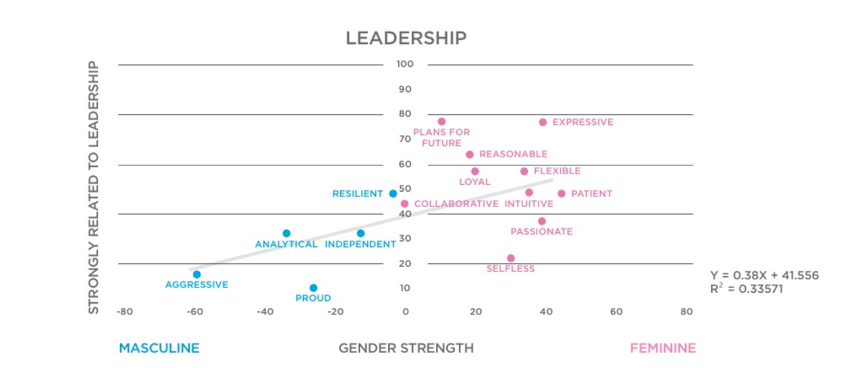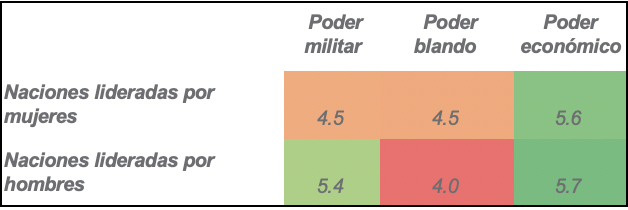
- Date of publication
- Enero 2021
- Business
- Article

Profesora de ESIC. Directora General, Brand Finance Institute. Especialista en gestión y evaluación de marcas.
Liderazgo y pandemia: los hombres son de Marte y las mujeres son de Venus
La pandemia ha reavivado un debate antiguo: ¿quiénes son mejores líderes en el entorno actual? ¿Las mujeres o los hombres?
Se ha escrito mucho sobre cómo las mujeres líderes han gestionado la pandemia mejor que sus homólogos masculinos. La mayoría de los análisis se han centrado en probar este vínculo sin tratar de identificar las causas de esa diferencia en los resultados y su implicación para el futuro del liderazgo político. Dada nuestra extensa base de datos del «Índice de poder blando global», nos propusimos responder a la que consideramos la pregunta más importante: ¿por qué las mujeres líderes parecen ser mejores líderes frente a la pandemia?
Para realizar este análisis, identificamos todos los países liderados por mujeres en nuestra base de datos. Solo ocho países están liderados por mujeres: Alemania, Suiza, Bélgica, Dinamarca, Noruega, Nueva Zelanda, Bangladesh y Myanmar. Para esos países, identificamos aquellos pilares y atributos en los que puntuaron mejor que el promedio, así como su impacto en la influencia general del país. Pero también, y con el fin de comprender qué rasgos del liderazgo femenino podrían explicar estos resultados, hicimos una extensa revisión de la literatura sobre el liderazgo femenino, sus rasgos e impacto. Identificar qué rasgos del liderazgo femenino están vinculados a mejores resultados es clave para comprender las razones por las que las mujeres líderes parecen estar desempeñándose mejor durante la crisis e incorporar esos aspectos al liderazgo moderno.
El futuro es femenino
Uno de los lemas más populares utilizados por las líderes feministas, «el futuro es femenino», tuvo su origen en los años 70 en Nueva York. Pero recientemente ha sido utilizado por activistas, personas influyentes y líderes políticos. Madame Gandhi, la artista electrónica y activista estadounidense, lanzó un tema con este lema como título. Hillary Clinton declaró en 2017 que «el futuro es femenino». Esto no es de extrañar en un entorno dominado por la política de identidad. Con solo buscar liderazgo femenino en Google, se obtienen 33 millones de resultados. Evidentemente, se ha escrito mucho sobre el asunto.
A pesar del interés que ha despertado el tema, entre las 500 empresas de Fortune solo hay 24 directoras ejecutivas frente a las 32 del año anterior, según el «Índice de Guardián de Marca» de Brand Finance de 2020. En este último, solo cuatro directoras ejecutivas aparecen entre los 100 primeros. Sin embargo, la mejor guardiana de la marca del mundo, según el análisis de Brand Finance, fue Marillyn Hewson, directora ejecutiva de Lockheed Martin. Las cuatro directoras ejecutivas del ranking, en promedio, se desempeñan mucho mejor en «Cobertura neta positiva» y «Dividendos promedio por acción», donde tienen una ventaja de 3,5 puntos sobre 10 por delante de sus homólogos masculinos.
Por otro lado, revisamos la literatura existente sobre el tema y, en función de sus objetivos y resultados, encontramos tres tipos de investigación:
- Aquellos que se proponen demostrar el vínculo entre el liderazgo femenino y los mejores resultados financieros.
- Aquellos que se proponen demostrar que los rasgos de liderazgo femenino son la causa de estos mejores resultados.
- Aquellos que se proponen demostrar que el estilo de liderazgo femenino (a menudo acuñado como liderazgo compasivo o liderazgo cauteloso) es preferido por la población en general.
En 2018, Nordea condujo una investigación para estudiar si la diversidad era rentable para los accionistas. Si bien no pudo probar el vínculo entre una mayor proporción de mujeres líderes y mayores rendimientos, mostró una correlación con una menor volatilidad en los rendimientos.
En 2016, MSCI descubrió que, en el período de 2011 a 2014, las empresas con tres o más mujeres gerentes tenían mayores ganancias por acción y rendimiento sobre el capital en comparación con las empresas sin directoras en el mismo período.
Goldman Sachs ha analizado recientemente 496 fondos de renta variable de empresas estadounidenses de gran capitalización y encontró que los fondos gestionados por mujeres superaron a los de sus homólogos masculinos en medio de las fluctuaciones del mercado relacionadas con el coronavirus (Flood, 2020).
En el segundo grupo de estudios, Corinne Post (2015) realizó un trabajo que mostró que los equipos liderados por mujeres obtuvieron puntuaciones más altas en cohesión, aprendizaje cooperativo y comunicación participativa, y que la ventaja del liderazgo femenino se amplió cuando los requisitos de coordinación eran más altos.
Dentro del tercer grupo, encontramos una miríada de estudios. Solo nos centraremos en los resultados de unos pocos. Un estudio reciente de Deloitte (2018) afirma que «los líderes modernos deben buscar equilibrar los rasgos de poder duro y blando». En realidad, ser comunicativo, flexible y paciente, rasgos de poder blando que generalmente se consideran femeninos, se encontraban entre los cinco factores más importantes para un liderazgo fuerte.
Otro estudio realizado por Harris Poll en 2018 mostró que la mitad de los estadounidenses preferirían trabajar para una empresa dirigida por una mujer líder (véase Berlin, C., 2018).
Todos los estudios discutidos anteriormente aportan pruebas sobre el vínculo entre liderazgo femenino o rasgos de liderazgo femenino y el impacto financiero o la preferencia social.
Ahora la pregunta es: ¿qué rasgos definen un estilo de liderazgo femenino? ¿Cómo tienden a liderar las mujeres? ¿Qué podemos clasificar como atributos típicamente femeninos o masculinos? Para responder a esta pregunta, realizamos más investigaciones.
Liderazgo y atributos femeninos y masculinos
John Gerzema y Michael D'Antonio investigaron sobre este tema de manera extensa. Estos autores encuestaron a 64.000 personas en 13 países y publicaron sus resultados en el libro The Athena Doctrine: How women (and the men who think like them) will rule the future, [La doctrina de Atenea: cómo las mujeres (y los hombres que piensan como ellas) gobernarán el futuro]. Su objetivo era descubrir «si, debido a la influencia de factores económicos, tecnológicos, generacionales u otros factores como la globalización, las personas en general podrían estar valorando más el lado femenino de la naturaleza humana». Algunos de los hallazgos clave apoyan esa hipótesis:
- El 66% de los encuestados pensaba que «el mundo sería un lugar mejor si los hombres pensaran más como mujeres».
- El 57% de los encuestados está «insatisfecho con la conducta de los hombres en su país».
Como parte del mismo trabajo, le pidieron a la mitad de su muestra que clasificara 125 rasgos humanos diferentes como masculinos, femeninos o neutrales. Atributos como rudo, dominante, agresivo y egoísta se clasificaron como masculinos, mientras que egoísmo, paciente, sensible, sincero, cariñoso y confiable se clasificaron como femeninos. Luego, les presentaron la misma lista de atributos a la otra mitad de su muestra y les pidieron que explicaran la importancia de esos rasgos para el liderazgo y el éxito. Al comparar los resultados de ambas muestras, determinaron qué atributos femeninos conformarían un líder moderno ideal (ver Figura 1).
Figura 1: Atributos femeninos más fuertemente relacionados con liderazgo

Fuente: Gerzema, J. y D'Antonio, M. (2013), p. 12
Lo que demuestran los datos es que la definición de liderazgo está cambiando y los rasgos masculinos como la agresión y el control se están volviendo menos efectivos que los atributos femeninos como la colaboración y la flexibilidad. Los autores concluyen que en «un mundo cada vez más social, interdependiente y transparente, (...) los valores femeninos están en auge».
Ahora, nuestra pregunta es: ¿son estos resultados del mundo empresarial igualmente válidos en el mundo de la diplomacia pública y la geopolítica? Para responder a esta pregunta, exploraremos los resultados de nuestro «Índice global de poder blando».
Las pruebas de nuestro «Índice global de poder blando»
El concepto de poder blando ha adquirido una relevancia cada vez mayor en el siglo XXI. El profesor Joseph Nye (2004) lo definió como «la capacidad de una nación para influenciar las preferencias y conductas de varios actores de la escena internacional (estados, corporaciones, comunidades, públicos, etc.) a través del atractivo o la persuasión más que de la coerción». Brand Finance publicó el «Global Soft Power Index», en febrero de 2020, con el fin de medir el poder blando de una nación, sus pilares y su impacto en la prosperidad.
La metodología de medición, basada en 55.000 encuestas a especialistas y público en general llevada a cabo en 100 países, incorpora un amplio rango de métricas que permiten evaluar de manera completa y equilibrada la presencia, reputación e impacto de las naciones en el mundo. Algunas de estas métricas son:
- Reconocimiento y familiaridad: A mayor reconocimiento, mayor poder blando.
- Influencia: El grado en que se considera que una nación tiene la capacidad para impactar en el mundo.
- Reputación: La estima en la que se tiene a una nación.
- Desempeño en los siete pilares del poder blando: Ambiente de negocios, gobierno, relaciones internacionales, patrimonio cultural, medios y comunicación, educación y ciencias, gente y valores). En la Figura 2 puede observarse cada uno de los pilares y las variables medidas en cada uno de ellos.
Figura 2: Pilares de poder blando

Fuente: «Global Soft Power Index 2020», Brand Finance
Aunque las naciones gobernadas por líderes masculinos, en promedio, tienen más influencia en general, se percibe que su influencia negativa es significativamente superior, en promedio, que en las naciones lideradas por mujeres. Las naciones lideradas por mujeres, en promedio, tienen una mejor reputación y una mayor influencia neta positiva (ver Figura 3). Las naciones lideradas por mujeres obtienen mejores resultados en gobierno, relaciones internacionales y negocios y comercio (Figura 4).
Figura 3: Reputación e influencia, «Global Soft Power Index 2020»

Fuente: «Global Soft Power Index 2020», Brand Finance
Figura 4: Atributos de poder blando, «Global Soft Power Index 2020»

Fuente: «Global Soft Power Index 2020», Brand Finance
De los atributos que medimos en nuestro «Índice de poder blando global», en promedio, las naciones lideradas por mujeres superan a las naciones lideradas por hombres en 26 de ellos, y solo tienen un desempeño inferior en nueve (ver Figura 5).
En particular, se perciben significativamente mejor en los siguientes atributos:
- Una economía fuerte y estable
- Actúa para proteger el medioambiente
- Buenas relaciones con otros países
- Seguridad y protección
- Estilo de vida atractivo
- Políticamente estable y bien gobernado
- Confiable
- Sistema educativo fuerte
- Estándares éticos estables y baja corrupción
La mayoría de estos atributos se relacionan con tres temas clave: estabilidad, seguridad y protección y confianza y ética. Muchos de estos atributos están relacionados con los valores clasificados como femeninos en la obra de Gerzema y D'Antonio (Gerzema, J. y D'Antonio, M., 2013).
Recientemente, Simon Sinek describió en su libro Los líderes comen al final cómo los líderes fuertes hoy en día hacen que las personas se sientan seguras. Este es probablemente uno de los rasgos comunes clave que se han destacado de las mujeres líderes en la pandemia: comunicaciones claras y acciones decisivas que hicieron que los ciudadanos se sintieran seguros.
La mayoría de los países liderados por mujeres obtuvieron mejores resultados incluso antes de la pandemia en estos rasgos: protección, estabilidad, seguridad, confianza. La necesidad de una mayor cooperación y multilateralismo provocada por la pandemia, en todo caso, ha potenciado aún más la importancia de un estilo de liderazgo basado en estos valores.
En este contexto, no es sorprendente que los alemanes llamen a la canciller Merkel Mutti (mamá) de la nación. Esto solo ejemplifica que, en un mundo cada vez más volátil, el liderazgo tiene que ver con la cooperación, la protección y la seguridad, valores en los que las naciones lideradas por mujeres superan a las lideradas por hombres.
Además, al comparar cómo se desempeñan las naciones en poder militar y económico, emerge un patrón interesante (ver Figura 5).
Figura 5: Poder militar, económico y blando

Fuente: «Global Soft Power Index 2020», Brand Finance, Global Fire Power, IMF
Si bien las naciones lideradas por mujeres y por hombres tienen un desempeño similar en términos de poder económico, la divergencia es evidente cuando se comparan las puntuaciones de poder duro y blando. Las naciones lideradas por hombres se desempeñan mejor en poder duro, mientras que las naciones lideradas por mujeres lideran en poder blando. Dado que el poder blando se considera una herramienta cada vez más importante para la prosperidad de una nación, los estilos de liderazgo femenino parecen estar bien situados para afrontar los cambios del futuro. La pandemia de coronavirus, el cambio climático, el conflicto social y la polarización son algunos de los mayores desafíos de nuestro tiempo que requieren cooperación, estabilidad y seguridad, atributos en los que las naciones lideradas por mujeres se desempeñan mejor que las naciones lideradas por hombres.
¿Podemos demostrar que estos resultados responden al 100% a la influencia femenina? La respuesta corta es «no». Una pregunta clave es si existe una correlación entre la duración en el cargo de las mujeres líderes y estos resultados o si estos resultados se han forjado antes de su mandato y las mujeres líderes los han acelerado. Muchos de estos resultados que discutimos se forjan a largo plazo.
También sabemos que, históricamente, ha habido mujeres líderes con una influencia negativa extraordinaria en sus naciones, reinos o ciudades. Las ha habido y las seguirá habiendo. Nuestro análisis apunta a estilos de liderazgo particulares basados en atributos que históricamente han sido reconocidos como más asociados a las mujeres. Además, es posible que la mayoría de las naciones lideradas por mujeres sean sociedades diversas e inclusivas, respetuosas de las diferencias y que brinden oportunidades y apoyo a un grupo diverso de talentos, lo que puede explicar la representación de las mujeres en puestos de poder, pero también la madurez de esa nación en muchos otros pilares del poder blando.
Esta podría ser la principal variable explicativa que hay detrás de la disparidad en los resultados de las naciones lideradas por mujeres: la inclusión. Como dice Rami Aboukhair, CEO de Santander España, «ninguna empresa que quiera crecer puede renunciar al talento, y las mujeres representan el 50%». Nosotros, en Brand Finance, hemos realizado un amplio análisis sobre el impacto de la diversidad y la inclusión en la fortaleza de la marca, y hemos encontrado un vínculo positivo significativo entre ambas variables (cf. https://brandfinance.com/knowledge-centre/whitepapers/stand-up-to-stand-out-how-brands-are-impacting-the-debate-on-social-justice/).
Si el talento femenino es tan importante para crecer, las corporaciones deben tomar medidas para garantizar la representación femenina en puestos ejecutivos. Estas acciones se pueden clasificar en tres grupos:
- Educación y formación: ¿Cómo puede la organización apoyar el desarrollo de mujeres líderes? A través de programas de mentoring, coaching y formación en habilidades específicas de liderazgo, entre otros. IBM es un gran ejemplo de una empresa que proporciona todas estas plataformas para mujeres líderes. En su división de EMEA, ha creado un programa de mentores «Women in Tech», así como una red abierta llamada «Inspired by Women», que educa sobre los sesgos inconscientes u obstáculos específicos en el desarrollo femenino y cómo abordar estos desafíos. Estas iniciativas no solo apoyan el desarrollo individual, sino que también permiten las conexiones necesarias para impulsar las carreras.
- Políticas y estándares: Políticas de flexibilidad, bajas extendidas y trabajo remoto son claves para muchas madres trabajadoras y un instrumento para evitar perder líderes femeninas con talento.
- Evaluación y reportes: Todo lo anterior suena bien, pero también es imperativo demostrar el impacto que tiene en términos de clima interno, satisfacción y retención de empleados. No solo eso: idealmente, debería estar vinculado a la creación de valor de marca. Medir el impacto de las iniciativas de D&I (diversidad e inclusión) orientadas a aprovechar el talento femenino es esencial para asegurar la inversión en este tipo de iniciativas.
Conclusiones
El análisis de nuestra base de datos muestra que las naciones lideradas por mujeres superan, en promedio, a aquellas lideradas por hombres en influencia positiva neta, reputación y la mayoría de los atributos bajo los siete pilares del poder blando, en particular los relacionados con la seguridad y la protección, la economía estable, la confiabilidad y la cooperación.
Aunque esto se basa en una muestra relativamente pequeña y reconociendo que estos resultados también pueden explicarse por muchos otros factores, después de analizar la literatura sobre los rasgos y el impacto del liderazgo femenino, podemos inferir que los valores femeninos definitivamente tienen un impacto positivo también desde el punto de vista geopolítico. Esto no quiere decir que las mujeres líderes estén libres de errores.
Como explicó Joseph Nye en una entrevista con David Haigh en septiembre de 2020, «las mujeres también son humanas y cometen errores». Pero el estilo de liderazgo femenino está definitivamente más relacionado con los atributos del poder blando que con los del poder duro. En el ámbito corporativo y geopolítico, estos atributos serán claves para generar influencia positiva y reputación en el futuro. Para asegurar que tengamos más de este tipo de liderazgo en el futuro, las organizaciones públicas y privadas deben centrarse en la capacitación, los estándares y la medición de la diversidad.
Jacinda Ardern, primera ministra de Nueva Zelanda y una de las líderes elogiadas por su gestión local de la pandemia, dijo recientemente: «Una de las críticas a las que me he enfrentado a lo largo de los años es que no soy lo suficientemente agresiva o asertiva, o tal vez, de alguna manera, ser empática significa que soy débil. Me rebelo totalmente contra eso. Me niego a creer que no se puede ser compasivo y fuerte a la vez». Esto subraya la importancia de un liderazgo compasivo en un entorno que se vuelve cada vez más volátil. Estamos convencidos de que un estilo de liderazgo basado en rasgos tradicionalmente femeninos tendrá un impacto positivo en un mundo plagado de polarización y conflicto, que requiere ahora más que nunca multilateralismo, colaboración y compasión.
Fuentes:
- Berlin, C. (2018). «Research Reveals Half of Americans Want to Work for a Female Leader». Puede descargarse del siguiente link: https://www.globenewswire.com/news-release/2018/01/25/1305181/0/en/Research-Reveals-Half-of-Americans-Want-to-Work-for-a-Female-Leader.html
- Brand Guardianship Index 2020. Puede descargarse del siguiente link: https://brandirectory.com/reports/brand-guardianship-index-2020
- Deloitte (2018). «What’s the future of leadership?». Puede descargarse del siguiente link: https://www.deloittedigital.com/us/en/blog-list/2018/what_s-the-future-of-leadership--read-about-our-new-research.html
- Flood, C. (2020). «Female-managed US funds outperform all-male rivals». Puede descargarse del siguiente link: https://www.ft.com/content/021a1b60-a5fa-42ad-83b4-482268cac7ac
- Gerzema, J. and D'Antonio, M. (2013). The Athena Doctrine: How women (and the men who think like them) will rule the future, Jossey-Bass, San Francisco, 1st Edition.
- Global Fire Power 2020. Puede descargarse del siguiente link: https://www.globalfirepower.com/
- Nordea (2018). «Investing in female leaders makes business sense». Puede descargarse del siguiente link: https://www.nordea.com/en/press-and-news/news-and-press-releases/news-group/2018/investing_in_female_leaders_makes_business_sense.html
- Nye, J. (2004). Soft Power: The Means to Success in World Politics, Public Affairs, NY, New York
- Post, C. (2015). «When is female leadership an advantage? Coordination requirements, team cohesion, and team interaction norms», Journal of Organizational Behaviour. Puede descargarse del siguiente link: https://doi.org/10.1002/job.2031
- Rubin, K. (2015). «Research: Investing in Women-led Fortune 1000 Companies». Puede descargarse del siguiente link: https://www.quantopian.com/posts/research-investing-in-women-led-fortune-1000-companies
- Sinek, S. (2015). Los líderes comen al final. Ediciones Urano, Barcelona.
You may also be interested in

Customer success: definition and how to implement it
In today's business environment, where competition is fierce and customer expectations continue to grow, customer success has become a key element in ensuring the success of a company's business.
- Published by _ESIC Business & Marketing School

What is the Ishikawa diagram and how to do it. Examples
How many times have we tried to solve a problem by patching it up, without going deep into the real cause, into the root of the problem? There are many companies that, when faced with crises or problems, try to...
- Published by _ESIC Business & Marketing School

JavaScript: what it is, what it is used for and examples
Undoubtedly, JavaScript is one of the most widely used programming languages worldwide. In fact, as early as 2021 it was being used by 14 million programmers according to Genbeta. The trend has been increasing...
- Published by _ESIC Business & Marketing School
